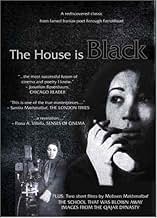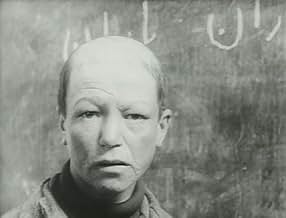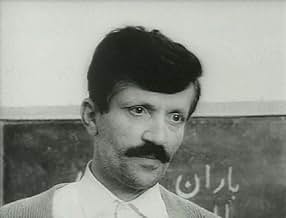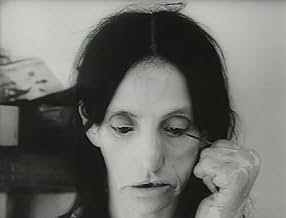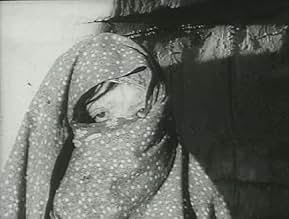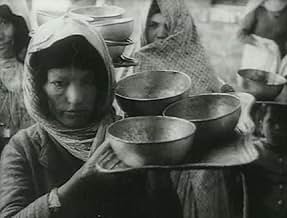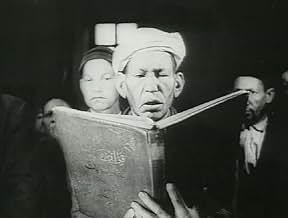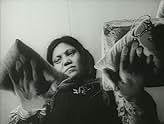IMDb-BEWERTUNG
7,8/10
6015
IHRE BEWERTUNG
Füge eine Handlung in deiner Sprache hinzuSet in a leper colony in the north of Iran, The House is Black juxtaposes "ugliness", of which there is much in the world as stated in the opening scenes, with religion and gratitude.Set in a leper colony in the north of Iran, The House is Black juxtaposes "ugliness", of which there is much in the world as stated in the opening scenes, with religion and gratitude.Set in a leper colony in the north of Iran, The House is Black juxtaposes "ugliness", of which there is much in the world as stated in the opening scenes, with religion and gratitude.
- Regie
- Drehbuch
- Hauptbesetzung
Forugh Farrokhzad
- Narrator
- (Nicht genannt)
Ebrahim Golestan
- Narrator
- (Nicht genannt)
Hossein Mansouri
- Self
- (Nicht genannt)
Empfohlene Bewertungen
I noticed some reviewers thought that MAYBE this film is about something other than its obvious subject, leprosy. Well, after seeing it, I think it's about leprosy. Sure, there's a bit more to it than that, but the film really does seem to be about lepers.
As the film progresses, various Muslim prayers and quotes from the Koran are read either by the narrator or by some of the subjects in the film. These are all about beauty and grace of God and are a sharp contrast to the lepers you see throughout the film. Although they appear very pitiful, most seem rather happy, though the film doesn't appear to try to say 'hey, it's great to be a leper'--more that in this day of medical miracles, Hansen's Disease (leprosy) IS curable and it's a horrible thing that so many go untreated. Forugh Farrokhzad (who wrote, directed and appears in the film) does not discuss WHY so many in her native Iran were untreated at the time--just that there is a SHARP contrast between the goodness of God and the plight of these people.
This film is unpleasant and will make you think. However, it's a very well made film--one that strikes the viewer with sadness and forces you to look into the ugly face of the illness.
As the film progresses, various Muslim prayers and quotes from the Koran are read either by the narrator or by some of the subjects in the film. These are all about beauty and grace of God and are a sharp contrast to the lepers you see throughout the film. Although they appear very pitiful, most seem rather happy, though the film doesn't appear to try to say 'hey, it's great to be a leper'--more that in this day of medical miracles, Hansen's Disease (leprosy) IS curable and it's a horrible thing that so many go untreated. Forugh Farrokhzad (who wrote, directed and appears in the film) does not discuss WHY so many in her native Iran were untreated at the time--just that there is a SHARP contrast between the goodness of God and the plight of these people.
This film is unpleasant and will make you think. However, it's a very well made film--one that strikes the viewer with sadness and forces you to look into the ugly face of the illness.
10evolv
One must consider why the religious emphasis is there. Everyone in this film has a message; the Iranians are known for their no frills directness when it comes to film-making.What is Farrokhzad saying about religion?
Additionally; is this film entirely about leprosy, or does it hint toward other kinds of corruption?
Is the previous reviewer certain that there were scripted scenes? I admit it's been a while so I can't clearly remember; however another rule of Iranian film is that can be very hard to distinguish the scripted and the natural. If you want to test this, check out Kiarostami's wonderful "Close-up" or Samira Makhmalbaf's "Apple". The events are real as are the actors, beyond that...well just watch em. With your thinking hat on.
OK i'm done.
Additionally; is this film entirely about leprosy, or does it hint toward other kinds of corruption?
Is the previous reviewer certain that there were scripted scenes? I admit it's been a while so I can't clearly remember; however another rule of Iranian film is that can be very hard to distinguish the scripted and the natural. If you want to test this, check out Kiarostami's wonderful "Close-up" or Samira Makhmalbaf's "Apple". The events are real as are the actors, beyond that...well just watch em. With your thinking hat on.
OK i'm done.
It was the only movie made by Forough Farrokhzad.
A documentary of 20 minutes length; actually it is a documentary only at the first level of meaning: the disturbing images from a leper colony are meditated in verses that partner what's flowing on the screen. Fragments from Psalms, from Koran, from her own poetry. And her stanzas, sometimes in sync with the images, some times in counterpoint, always challenging the versets from the sacred books. One of the greatest poets of the twentieth century, that's what I believe Forough Farrokhzad is.
This movie is a cinematic poem: empathy for the extreme suffering, desolation that we cannot escape from our condition, and, in the same time, awe in face of the beauty of creation.
I think the key of the movie is done by two verses:
Who is this in hell Praising you, O Lord?
The hell is also part of the world; and it is ultimately beautiful because world is beautiful.
This is extraordinary here in the movie: the subtle impulse to see the Universe as beautiful in all its dimensions, even in its ugliest expressions - to see the splendor of the human condition, even in its most horrible shape.
Or maybe the verses tell us something slightly different: as they are in turn fearful, desolate, bitter, pessimistic, sarcastic against God and praising God, it is here the honesty and the courage of the poet to recognize having all these contradictory feelings. And this speaks indeed about the splendor of the human condition: to encompass everything, to assume all contradictions, to be their sovereign - as the Universe is.
A documentary of 20 minutes length; actually it is a documentary only at the first level of meaning: the disturbing images from a leper colony are meditated in verses that partner what's flowing on the screen. Fragments from Psalms, from Koran, from her own poetry. And her stanzas, sometimes in sync with the images, some times in counterpoint, always challenging the versets from the sacred books. One of the greatest poets of the twentieth century, that's what I believe Forough Farrokhzad is.
This movie is a cinematic poem: empathy for the extreme suffering, desolation that we cannot escape from our condition, and, in the same time, awe in face of the beauty of creation.
I think the key of the movie is done by two verses:
Who is this in hell Praising you, O Lord?
The hell is also part of the world; and it is ultimately beautiful because world is beautiful.
This is extraordinary here in the movie: the subtle impulse to see the Universe as beautiful in all its dimensions, even in its ugliest expressions - to see the splendor of the human condition, even in its most horrible shape.
Or maybe the verses tell us something slightly different: as they are in turn fearful, desolate, bitter, pessimistic, sarcastic against God and praising God, it is here the honesty and the courage of the poet to recognize having all these contradictory feelings. And this speaks indeed about the splendor of the human condition: to encompass everything, to assume all contradictions, to be their sovereign - as the Universe is.
I hope my son's upcoming college class on Iranian film will be enlightening and enjoyable. In preparation for that, his instructor asked him to watch this short from Forugh Farrokhzad.
I had heard her name before but thought she was exclusively a writer (and one I have not yet read, alas).
Seeing this film....and reading a little more about her, was illuminating. And added to the spell that Iranian art has cast upon me.
It starts with an image, a reflection in a mirror. A scarred face, covered both by hijab and leprosy - with one eye searching. Who is watching who?
Actually, that is a lie. It starts with words. As befits a poet.
The film is available online, and I would almost recommend just reading the subtitles once through (or if they are excerpted somewhere, read them there before watching). Granted, I can only take in English, my tongue far from mastering Farsi. So hearing the words, Farrokhzad's long-gone but still-not-silent voice are part of the experience. Soft repetitions, almost mantras or prayers. Much questioning.
Is this the film that launched Kiarostami, Farhadi and others? There is an unflinching look at society. There is a tendency towards a more poetic than precise description. Thought above plot. Images too that may contrast the official story, of the film....or of the censors.
Images linger too - aspects of beauty, the combing of hair, and a camera pan to reveal. The applying of kohl with ravaged hands to a ravaged face. Still there is pride, there is beauty. The camera jumps into the middle of a volleyball game. We are there with them. We are them.
I do think that is the simple story here, Davids Bowie and Lynch gave us "Elephant Man." Farrokhzad moves through similar stark shadows. Honestly there is more light here. In a documentary. That dancing/singing/humming man. The laughter in the class room. Food, music, learning, work, love - these define us all as humans.
Anyways, I look forward to watching the movies in parallel with my son and his classmates. I've previously seen about half of them, which I will enjoy revisiting, like meeting up with a dear forgotten friend. But new introductions like these, I too will cherish.
Reading up on Farrokhzad, it is hard not to think of the film at least partially as a pariah dismissing those who dismiss her. There is a cure for leprosy, the film plainly repeats, though it is not a soft prayer, it is a hard fact. That said there is a biological cure, but perhaps not a societal one.
Like the great Iranian films that followed this one, there may be something that is not said and said at the same time.
There is so much beneath the surface. Of cinema, of society, of skin.
I had heard her name before but thought she was exclusively a writer (and one I have not yet read, alas).
Seeing this film....and reading a little more about her, was illuminating. And added to the spell that Iranian art has cast upon me.
It starts with an image, a reflection in a mirror. A scarred face, covered both by hijab and leprosy - with one eye searching. Who is watching who?
Actually, that is a lie. It starts with words. As befits a poet.
The film is available online, and I would almost recommend just reading the subtitles once through (or if they are excerpted somewhere, read them there before watching). Granted, I can only take in English, my tongue far from mastering Farsi. So hearing the words, Farrokhzad's long-gone but still-not-silent voice are part of the experience. Soft repetitions, almost mantras or prayers. Much questioning.
Is this the film that launched Kiarostami, Farhadi and others? There is an unflinching look at society. There is a tendency towards a more poetic than precise description. Thought above plot. Images too that may contrast the official story, of the film....or of the censors.
Images linger too - aspects of beauty, the combing of hair, and a camera pan to reveal. The applying of kohl with ravaged hands to a ravaged face. Still there is pride, there is beauty. The camera jumps into the middle of a volleyball game. We are there with them. We are them.
I do think that is the simple story here, Davids Bowie and Lynch gave us "Elephant Man." Farrokhzad moves through similar stark shadows. Honestly there is more light here. In a documentary. That dancing/singing/humming man. The laughter in the class room. Food, music, learning, work, love - these define us all as humans.
Anyways, I look forward to watching the movies in parallel with my son and his classmates. I've previously seen about half of them, which I will enjoy revisiting, like meeting up with a dear forgotten friend. But new introductions like these, I too will cherish.
Reading up on Farrokhzad, it is hard not to think of the film at least partially as a pariah dismissing those who dismiss her. There is a cure for leprosy, the film plainly repeats, though it is not a soft prayer, it is a hard fact. That said there is a biological cure, but perhaps not a societal one.
Like the great Iranian films that followed this one, there may be something that is not said and said at the same time.
There is so much beneath the surface. Of cinema, of society, of skin.
Masterpiece is the basis of a documentary of its time to this day.
Therefore, Iran's documentary career honor the backing of this work.
Although successful movies have been seen in the Iranian documentary cinema from the first to present day, the collaboration of Ebrahim Golestan and Dear Forough Farrokhzad with documentary subjects has largely distinguished this film.
The documentary refers to a place where lepers people are taken from quarantined villagers.
The colony of lepers living together in an enclosed environment.
The most important thing in the audience's beliefs, as the name suggests, is the mere darkness of the world of leprosy, but with a particular look it can be concluded that the general documented theme is life expectancy.
This look can be viewed from a more in-depth angle at the wedding, kids' play and classroom. Because they laugh, despite physical problems, they play and even get married.
In any case, we can not rule out that the glass of water, in addition to half empty, has full half.
Forough Farrokhzad have lived for about ten days in order to accompany and coordinate of filming, and this represents a great spirit and professional approach.
Signs indicate that the documentary has the 19th place among the fifty documentary titles in the world, in the site and sond, which is typically a special art work for Iran.
Wusstest du schon
- WissenswertesIt was the only film Farrokhzad directed before her death in 1967. During shooting, she became attached to a child of two lepers, whom she later adopted.
- VerbindungenFeatured in Cinema Iran (2005)
Top-Auswahl
Melde dich zum Bewerten an und greife auf die Watchlist für personalisierte Empfehlungen zu.
Details
- Laufzeit
- 20 Min.
- Farbe
- Sound-Mix
- Seitenverhältnis
- 1.37 : 1
Zu dieser Seite beitragen
Bearbeitung vorschlagen oder fehlenden Inhalt hinzufügen

